Accepted Scientific Name: Stapelia paniculata subs. scitula (L.C.Leach) Bruyns
Stapeliads S. Africa Madagascar 2: 446. 2005 Bruyns
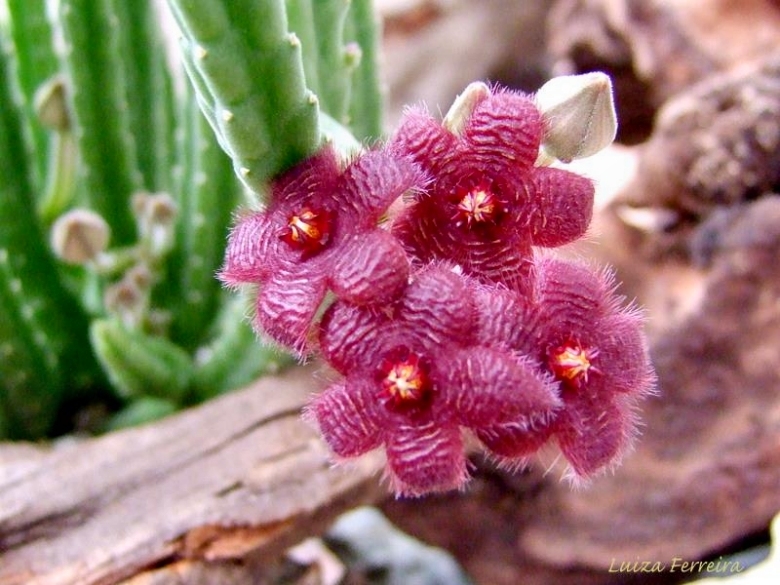
Gonostemon scitulus (Stapelia paniculata subs. scitula) Photo by: Luiza Ferreira
Origin and Habitat: Stapelia paniculataSN|30230]]SN|30230]] subs. scitula is known from a restricted range in the Robertson district, Western Cape, Republic of South Africa (extent of occurrence less than 300 km2), and recorded from three locations (Langvlei, Eilandia, and on the immediate foothills of the Langeberg at Tier-hock) but supposed to occur at a few others, possibly up to 10.
Altitude range: 400-600 metres above sea level.
Habitat and Ecology: This species usually grows on steep shale and dolomitic slopes in fynbos (dry fine bush vegetation). It is declining in habitat as a result of vineyard and fruit orchard expansion and quarrying.
Synonyms:
See all synonyms of Stapelia paniculata
Common Names include:
ENGLISH: Starfish Flower, Small Starfish Flower, Mini Starfish Flower
Description: The Small Starfish Flower, Stapelia paniculataSN|30263]]SN|30230]] subs. scitula (= Stapelia scitulaSN|30263]]SN|30294]]), is a cute and pretty miniature version of the larger Stapelias, its slender, light green stems are no more than 7 mm across and 8 cm height and forms compact clumps. Throughout the year, it is adorned with proportionately diminutive star-shaped blooms, each less than 2.5 cm across, magenta or dark chestnut-brown with or without yellowish bands and densely covered with purple or maroon hairs. The flowers have not the strong, foetid odour typical of stapeliads, but have a delicate foul fragrance and one has to sniff closely to pick upon it. This would not be an offensive house plant even when in bloom. It is a free-blooming species and at times prolific.
Derivation of specific name: The specific name comes from the Latin word 'scitulus', = 'neat' for the slender stems that stand neatly erect.
Stems: Young with flat sides, older slenderly cylindrical, up to 7.5 tall (12 or more cm in shade), 5-7 mm thick, apically branching and forming small orderly clumps, pale green, later purple. Tbercles rounded, obscure with age.
L rudiments 1 - 1.5 mm, acutely ovate, caducous, stipular rudi-ments cream-coloured.
Inflorescence: Basal, with several flowers opening successively, peduncle clump-like.
Flowers: Flower buds broadly ovate, acute. Pedicels 9 - 15 mm long. Sepals ca. 5 long, 1.5 mm wide, sometimes visible between the corolla-lobes. Corolla rotate, more or less strongly curved outwards,15-26 mm across, outside pale green, venation darker, inside magenta or dark chestnut-brown densely covered with long-pointed, purple or maroon hairs. Corolla-lobes 5-9 mm long, ca. 5 mm wide, rugulose, reflexed in the older flower, outside delicately pubescent, basis inside, yellow, tips greenish-yellow, inner face densely hairy, hairs longer on the margins. Outer corona pale brown, lobes ca. 1 mm long, oblong more or leass square, concave, spreading. Inner lobes erect, black-purple, lobes narrowly ovate, long-attenuate, slightly recurved, dorsal wings prominent, erectly spreading, broadly 3-angled. Pollinia yellowish, 0.6 x 0.4 mm, D-shaped.
Fruits: The fruit are paired spindle-shaped capsules (follicles) with the tightly packed seeds inside. At maturity they split open to release numerous small brown seeds crowned with long white hairs.
Related species: Stapelia scitulaSN|30233]]SN|30294]] is closely related to Stapelia immelmaniaeSN|30294]]SN|30233]] of the Piquet-berg Mountains, with taller stems up to 20 cm long and 15 mm thick, with flowers 40-45 mm across. Stapelia montanaSN|30294]]SN|30263]] is also very similar to S. scitula, but is separated by having outer corona lobes twice as long. Stapelia montanaSN|30230]]SN|30263]] var. grossa is also similar but larger in size.
Subspecies, varieties, forms and cultivars of plants belonging to the Stapelia paniculata group
Bibliography: Major references and further lectures
1) Bruyns, P.V. 2005. "Stapeliads of southern Africa and Madagascar." (Vol. 1, pp. 1-330). Umdaus Press, Pretoria.
2) Helme, N.A. & Raimondo, D. 2007. "Stapelia paniculata Willd. subsp. scitula (L.C.Leach) Bruyns." National Assessment: Red List of South African Plants version 2014.1. Accessed on 2015/03/11
3) Focke Albers, Ulrich Meve “Illustrated Handbook of Succulent Plants: Asclepiadaceae: Asclepiadaceae” Volume 4 Springer Science & Business Media, 2002
4) Southern Africa: G. GERMISHUIZEN & N.L. MEYER, eds, (2003). "Plants of Southern Africa: an annotated checklist" Pretoria.
5) African Plants Database (version 3.4.0). Conservatoire et Jardin botaniques de la Ville de Genève and South African National Biodiversity Institute, Pretoria, "Retrieved 11 Mar. 2015", from <http://www.ville-ge.ch/musinfo/bd/cjb/africa/>.
6) Doreen Court “Succulent Flora of Southern Africa” A.A. Balkema, 2000
7) Illustration: Cactus and Succulent Journal, Vol. 81 (2), March - April, 2009
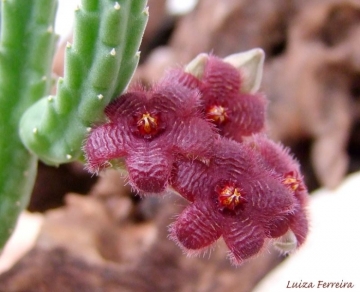 Gonostemon scitulus (Stapelia paniculata subs. scitula) Photo by: Luiza Ferreira
Gonostemon scitulus (Stapelia paniculata subs. scitula) Photo by: Luiza Ferreira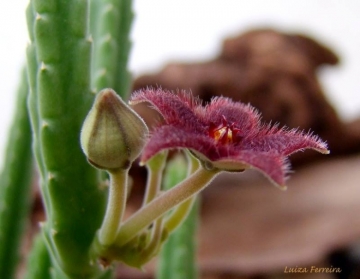 Gonostemon scitulus (Stapelia paniculata subs. scitula) Photo by: Luiza Ferreira
Gonostemon scitulus (Stapelia paniculata subs. scitula) Photo by: Luiza Ferreira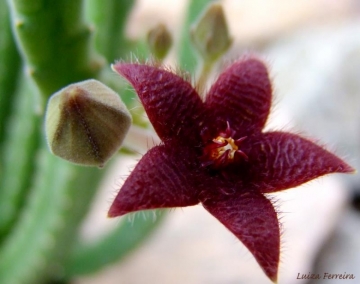 Gonostemon scitulus (Stapelia paniculata subs. scitula) Photo by: Luiza Ferreira
Gonostemon scitulus (Stapelia paniculata subs. scitula) Photo by: Luiza Ferreira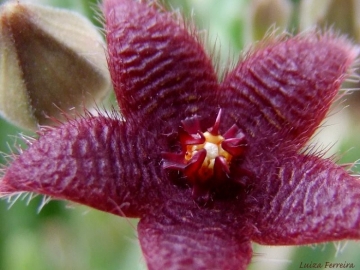 Gonostemon scitulus (Stapelia paniculata subs. scitula) Photo by: Luiza Ferreira
Gonostemon scitulus (Stapelia paniculata subs. scitula) Photo by: Luiza FerreiraCultivation and Propagation: Stapelia paniculataSN|30230]]SN|30230]] subs. scitula is a quick-growing species that blooms easily when mature. This species makes a small bushy, full plant which works well as a potted plant and is the perfect species for a sunny dry windowsill, especially where room is limited. They require moderately watering through the growing season but enjoy plenty of water and some fertiliser in hot weather, this helps them to flower freely. Water more sparingly in winter according to temperatures. But, as with most asclepiads, it is unwise to leave them wet in cold weather. Winter care presents no problems at 5°C with plenty of light. Since roots are quite shallow, use a cactus mix or add extra perlite or pumice to regular soil potting soil. A gritty, very free-draining compost is suitable, and clay pots help the plants to dry out between watering.
Sun Exposure: Partial sun or light shade
Pest and diseases: Stapelia species vary in their susceptibility to rotting, but are generally fairly easy to grow, especially if kept pest-free. They are very susceptible to stem and root mealy bugs, and damage from these may well initiate fungal attack. If you do have problems with a stem or with basal rotting, you can reliably isolate the healthy parts, dry them off, and re-root them in moist compost.
Cultural Practices: Re-pot every 2 years.
Propagation: Easiest with stem cuttings. Allow cuttings to dry a day before planting. Stems must be laid (Not buried) on gritty compost and will then root from the underside of the stems. It can also be increased from seeds sowing in spring in moist, sandy peat moss.
Potting medium: Since roots are quite shallow, use a cactus mix or add extra perlite or pumice to regular soil potting soil. A gritty, very free-draining compost is suitable, and clay pots help the plants to dry out between watering.














